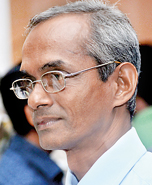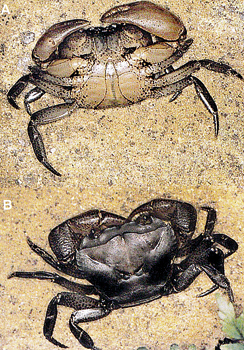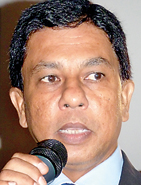A man who made them all ‘wild-men’
Earlier this month the Wildlife Conservation Society of Galle launched its first major publication “Sri Lankan Primates: An Enthusiasts’ Guide” before a gathering of the wildlife community. The book was dedicated to a man little known to the public: Dharma Sri Kandamby. The dedication read- “To Dharma Sri Kandamby, Founder Patron of the Galle Wildlife Conservation Society for his guidance and inspiration”.

Dharma Sri Kandamby: A mentor and guide
Curator of the Galle Maritime Museum, Mr. Kandamby retires this month, after a lifetime of service to conservation, guiding many young people in Galle who have gone on to become well-known scientists today.
When the time came to present the first copies of the book, the authors Madura De Silva and Nadika Hapuarachchi invited Mr. Kandamby on stage. After handing over the first copy, Madhura knelt before ‘Kandamby Sir’ to pay tribute to his first teacher in wildlife – the man who helped him come this far in the field. Hundreds of unsaid words would have been expressed between these conservationists from two generations in the emotional hug on stage.
“I was so happy when I learned from Madura de Silva and Nadika Hapuarachchi that they wanted to dedicate their book on Primates to Mr. Kandamby. It makes me proud to know that none of these young men have forgotten their teacher and their mentor,” said Rohan Pethiyagoda who contributed the text of the book.
“Kandamby Sir” as they call him has also been a great source of inspiration to the young naturalists of the Galle Wildlife Conservation Society at Hiyare. Recalling the early days, Madhura, who has been the society’s president since its inception said that back in 1992 a few nature lovers had gathered together with the intention of forming a Wildlife Society. “But we neither had direction nor proper resources to learn about wildlife. Luckily we heard that the Galle Maritime Museum had an expert on wildlife and decided to go and meet him to get his support.” Madura and his friends were then studying for their Advanced Levels.
“I wanted to check whether their intentions were genuine. An interest in nature alone wouldn’t work as real conservationists need discipline and ethics,” Mr. Kandamby said remembering that first meeting. “I believe conservation begins with a love for nature. To love nature, one needs to be knowledgeable- so education plays a major role.” Mr. Kandamby’s vision on conservation also became the vision for the Galle Conservation Society. Soon the Maritime Museum became the study centre for members of the Galle Conservation Society. But membership was not something obtained overnight. One needed to attend a few classes and show an interest in studying at least one animal group to become a full-time member.
Madura also praises Mr. Kandamby’s approach to conservation. “As youngsters, we always want to catch animals such as snakes. But Mr. Kandamby always discouraged us from doing that. He taught us to be patient and made us first understand animal behaviour.” It wasn’t an easy task two decades ago as there were only few guides and colour illustrations that helped identify animals or plants.
But under such guidance, many prominent researchers on wildlife have emerged from Galle. The list starts with Mohammed Bahir who is now the authority on freshwater crabs, a species that records the highest endemism in Sri Lanka. The researcher never forgot his mentor and paid tribute to him in 2005 by naming a freshwater crab that is new to science as Ceylonthelphusa Kandambyi. Other young naturalists who had been inspired by Mr Kandamby include Sudath Nanayakkara, Sudesh Batuwita, Dr. Kalana Maduwage and Dr. Anjana Silva.

Ceylonthelphusa Kandambyi: The freshwater crab discovered by Mohammed Bahir, named after his mentor
Dr. Kalana Maduwage who has discovered many new species of snakes testifies that Mr.Kandamby is the most inspiring teacher that he has ever met. “He has the ability of using different teaching methods for different students according to their talents and interest, which was the reason for their successful careers. The outcome of his teaching ability is expressed in the discovery of more then 100 new species by his students,” Kalana added.
Sudath Nanayakkara who is now managing the Agra Arboretum and WHT research centre recalls memories of the days Mr. Kandamby kept the Maritime Museum open for him to study when he came in late after attending another technical course.
Mr. Kandamby remains the modest man he always has been. “After Madura and others came to leadership, I let them run the association on their own.
I’m really happy that the society which is still young has come this far,” he said. Before he became curator of the Galle Maritime Museum in Galle in 1992, he was attached to the National Museum’s Zoological Lab where researchers would often come to study specimens. Joining as a technical officer, he studied on his own and associating with top scientists both local and international helped further his knowledge on reptiles, amphibians and fish. His presence in the museum also made the researchers’ task easier, as he could point out any specimen they were looking at quickly.
“Mr. Kandamby understood the importance of type specimens on which the description and name of a new species is based and put extra care into preserving them,” said well-known researcher Kalum Manamendrarachchie who has discovered a number of new amphibians.
Wildlife expert Rohan Pethiyagoda who published the landmark guide to Freshwater Fish was only an amateur naturalist when he first met Dharma Sri Kandamby back in 1988, almost 25 years ago. “I was preparing to write my book on freshwater fishes and I went to the museum to look at some of the type specimens. Mr. Kandamby immediately made me feel very welcome and offered to help me in any way he could. I went on to spend many happy days in his company in the museum. I was incredibly impressed by how much he knew about fish and how readily and unselfishly he shared his knowledge with me, going to a lot of trouble to find specimens and refer old registers,” Rohan said.
Most of the country’s wildlife societies are based in Colombo, so Mr. Kandamby’s contribution to Galle producing so many young naturalists cannot be forgotten. Rohan Pethiyagoda’s comment may be the most fitting tribute to this quiet man of science. “I sometimes wonder what natural history studies in Sri Lanka would have been like if there were a “Mr. Kandamby” in every town in Sri Lanka. Can you imagine how many young people could have been inspired? But sadly, there is only one Mr Kandamby, and for him we must all be grateful.”
Follow @timesonlinelk
comments powered by Disqus



















